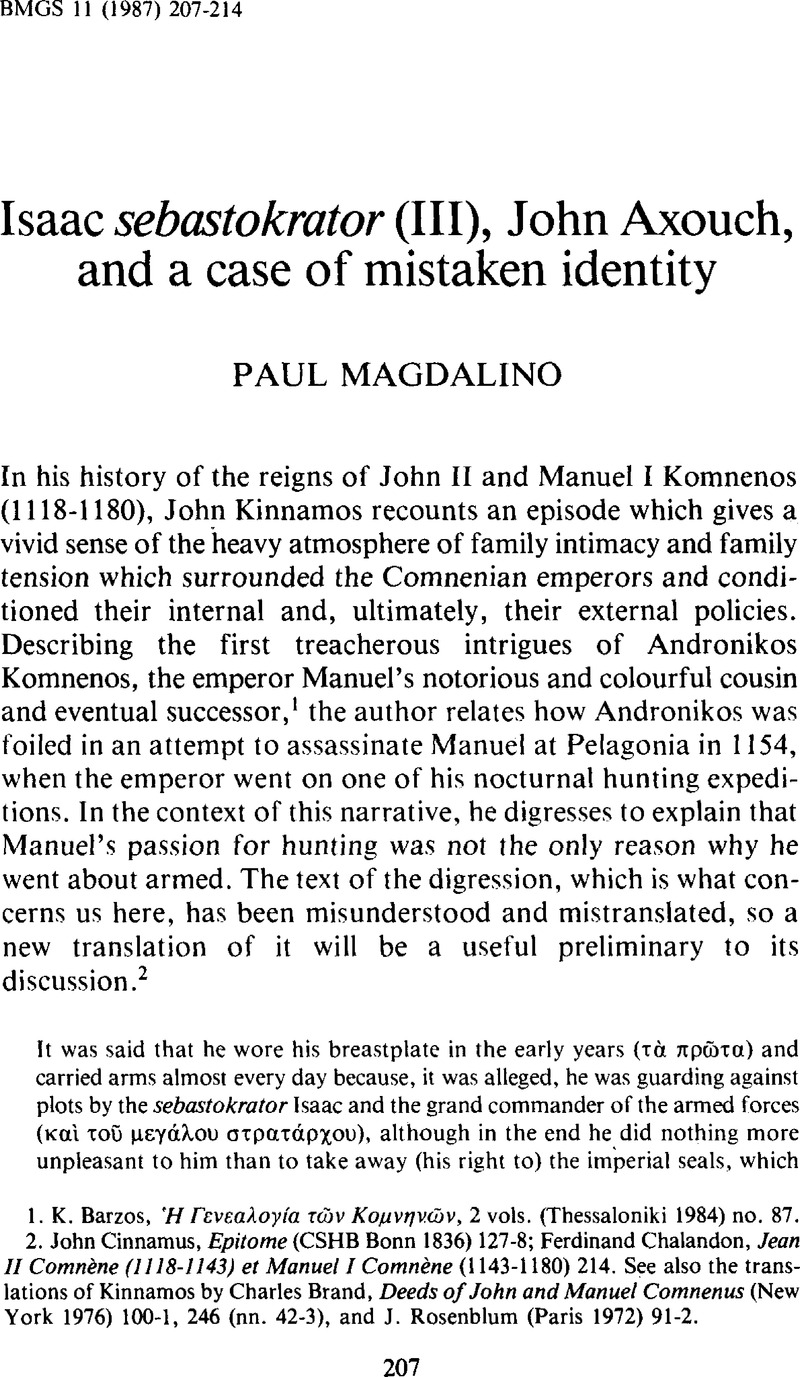No CrossRef data available.
Article contents
Isaac sebastokrator (III), John Axouch, and a case of mistaken identity
Published online by Cambridge University Press: 22 January 2016
Abstract

- Type
- Short Notes
- Information
- Copyright
- Copyright © The Centre for Byzantine, Ottoman and Modern Greek Studies, University of Birmingham 1987
References
1.
Barzos, K., ![]() 2 vols. (Thessaloniki
1984) no. 87.Google Scholar
2 vols. (Thessaloniki
1984) no. 87.Google Scholar
2. Cinnamus, John, Epitome (CSHB Bonn 1836) 127–8 Google Scholar; Chalandon, Ferdinand, Jean II Comnène (1118-1143) et Manuel I Comnène (1143-1180) 214 Google Scholar. See also the translations of Kinnamos by Brand, Charles, Deeds of John and Manuel Comnenus (New York 1976) 100–1 Google Scholar, 246 (nn. 42-3), and Rosenblum, J. (Paris 1972) 91–2.Google Scholar
3. Cinnamus, 36; Brand, 37, 238 (n.12).
4. Cf. ibid. 4 for the author’s attitude to Andronikos.
5. Barzos, no. 78.
6. Ibid. no. 36.
7. Brand, 246 n. 43.
8. Barzos, nos. 66, 83, 90; see esp. vol. I, 320.
9. On him, see Darrouzès, J., Georges et Démétrios Tornikès, Lettres et discours (Paris 1970) 45f.Google Scholar
10. Barzos, not unreasonably, thinks the reference is to Manuel’s nephew John Komnenos, whom Kinnamos (126) has recently mentioned as the object of Andronikos’ jealously in the early 1150s: Barzos, II, 148 (no. 128). However, it requires some effort of imagination to re-concile this John’s evident devotion to Manuel (who acted as a second father to him: cf. BF 8 [1982] 135-6) with the sentiments expressed by the person with whom we are concerned. When Kinnamos next mentions John Komnenos, he specifies that he is the emperor’s nephew (p. 129). I further exclude the identification on the basis of the arguments advanced in my next paragraph.
11. Above, n. 2; see also Angold, M., The Byzantine Empire 1025-1204, A Political History (London 1984) 220.Google Scholar
12. Brand, loc. cit.
13. Cinnamus, 152.
14. I take the reference to be not to the actual seals (of wax, lead, or gold), but to the stamping devices (boulloteria) with which they were formed, and which, I presume, John (and perhaps other officials) operated on the emperor’s behalf: cf. Oikonomides, N., ‘The Usual Lead Seal’, DOP31 (1983) 147f. There may be a case for connecting this operation with the dio-formula associated with the wax seals on imperial documents: see R. Macrides, ‘Justice under Manual I Komnenos. Four Novels on Court Business and Murder’, Fontes Minores 6 (1984) 103ff., 138.Google Scholar
15. The comments of Hohlweg, A., Beitràge zur Verwaltungsgeschichte des ostròmischen Reiches unter den Komnenen (Munich 1965) 131 Google Scholar, followed by Brand, 246 n. 42, are based on the mistaken assumption that the designation applies to Isaac.
16. See Guilland, R., ‘Le Stratopédarque et le Grand Stratopédarque’, Recherches sur les institutions byzantines (Berlin/Amsterdam 1967) I, 498–521.Google Scholar
17. Cinnamus, 5, 47, 51, 102.
18. Choniates, ed. Dieten, J.-L. Van (CFHB, Berlin/New York 1975) 9–10 Google Scholar.
19. Beck, H.-G., ‘Der byzantinische “Ministerprasident”’, SZ48 (1955) 322f., 330ff; repr. in idem, Ideen und Realitaeten in Byzanz (London 1972).Google Scholar
20. See Gautier, P., Michel Italikos, Lettres et discours (Paris 1972) 41ff.Google Scholar
21. Choniates, 46, 48-9.
22. See above, n. 15; cf. also Cinnamus, 98 lines 6 ff., which probably refers to Axouch.
23. Ibid. 47 ff., 51.
24. Ibid. 265-9; Choniates, 143-6.
25. I deal with both questions in my study, in progress, of the emperor Manuel I.
26. William of Tyre, Chronicon XV.23 (ed. R.B.C. Huygens, II, Corpus Chris- tianorum, Continuatio Medievalis, 63A (Turnhout 1986) 705). Cf. P. Magdalino, ‘The not-so-secret functions of the mystikos’, REB 42 (1984) 234.Google Scholar


